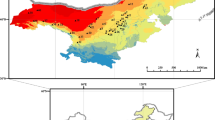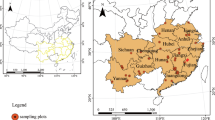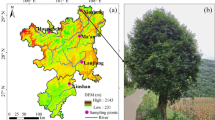Abstract
Although it is widely acknowledged that the variation in leaf morphology reflects the adaptation of plants to local environments, we know little about how leaf morphology varies at large scales and which environmental factors drive such variation, especially for closely related species. Along broad climatic and soil gradients in eastern and central China, we evaluated the geographical pattern and the effects of environmental gradients on the variation in leaf geometric morphometrics of 1,041 plants of 60 Artemisia species. Species identity explained the largest variation in leaf geometric morphometrics. Leaf geometric morphometrics exhibited a significant latitudinal pattern. As latitude increased, oblanceolate moderate three-lobed leaves changed gradually to elliptic integrifolious ones. Regional environmental gradients, including mean annual precipitation (MAP), soil organic carbon (SOC) and pH, had significant (but different) effects on leaf geometric morphometrics. These results suggest that although leaf geometric morphometrics of Artemisia are under strong genetic control, they respond significantly to changing environmental conditions. Our study demonstrates that the high responsiveness in leaf morphology to the environment could reflect important adaptation by which plants function efficiently along broad environmental gradients.





Similar content being viewed by others
Data availability
Data are available at: https://doi.org/10.5281/zenodo.8046197.
References
Abraham E, Kyriazopoulos A, Parissi Z et al (2014) Growth, dry matter production, phenotypic plasticity, and nutritive value of three natural populations of Dactylis glomerata L. under various shading treatments. Agrofor Syst 88:287–299
Adams DC, Otárola-Castillo E (2013) Geomorph: an R package for the collection and analysis of geometric morphometric shape data. Methods Ecol Evol 4:393–399
Bott T, Meyer GA, Young EB (2008) Nutrient limitation and morphological plasticity of the carnivorous pitcher plant Sarracenia purpurea in contrasting wetland environments. New Phytol 180:631–641
Campitelli BE, Stinchcombe JR (2013) Natural selection maintains a single-locus leaf shape cline in ivyleaf morning glory, Ipomoea hederacea. Mol Ecol 22:552–564
Chitwood DH, Headland LR, Filiault DL et al (2012) Native environment modulates leaf size and response to simulated foliar shade across wild tomato species. PLoS ONE 7:e29570
Chitwood DH, Sinha NR (2016) Evolutionary and environmental forces sculpting leaf development. Curr Biol 26:R297–R306
Conesa M, Mus M, Rosselló J (2012) Leaf shape variation and taxonomic boundaries in two sympatric rupicolous species of Helichrysum (Asteraceae: Gnaphalieae), assessed by linear measurements and geometric morphometry. Biol J Lin Soc 106:498–513
Creese C, Lee A, Sack L (2011) Drivers of morphological diversity and distribution in the Hawaiian fern flora: trait associations with size, growth form, and environment. Am J Bot 98:956–966
Cuevas-Reyes P, Oyama K, González-Rodríguez A, Fernandes GW, Mendoza-Cuenca L (2011) Contrasting herbivory patterns and leaf fluctuating asymmetry in Heliocarpus pallidus between different habitat types within a Mexican tropical dry forest. J Trop Ecol 27:383–391
Cunningham SA, Summerhayes B, Westoby M (1999) Evolutionary divergences in leaf structure and chemistry, comparing rainfall and soil nutrient gradients. Ecol Monogr 69:569–588
Danquah JA (2010) Phenotypic plasticity of leaf length to an environmental gradient in Khaya ivorensis (Meliaceae) populations in Ghana. Afr J Environ Sci Technol 4:860–865
Doi H, Takahashi M (2008) Latitudinal patterns in the phenological responses of leaf colouring and leaf fall to climate change in Japan. Glob Ecol Biogeogr 17:556–561
Ehleringer JR, Mooney HA (1978) Leaf hairs: Effects on physiological activity and adaptive value to a desert shrub. Oecologia 37:183–200
FAO/IIASA/ISRIC/ISSCAS/JRC. 2012. Harmonized world soil database (ver. 1.2). – FAO, Rome, Italy and IIASA.
Fick SE, Hijmans RJ (2017) Worldclim 2: new 1-km spatial resolution climate surfaces for global land areas. Int J Climatol 37:4302–4315
Gallaher TJ, Adams DC, Attigala L et al (2019) Leaf shape and size track habitat transitions across forest–grassland boundaries in the grass family (Poaceae). Evolution 73:927–946
Garcia S, McArthur ED, Pellicer J, Sanderson SC, Vallès J, Garnatje T (2011) A molecular phylogenetic approach to western North America endemic Artemisia and allies (Asteraceae): untangling the sagebrushes. Am J Bot 98:638–653
Ge QS, Zheng JY, Hao ZX, Liu HL (2013) General characteristics of climate changes during the past 2000 years in China. Sci China Earth Sci 56:321–329
Glennon KL, Cron GV (2015) Climate and leaf shape relationships in four Helichrysum species from the Eastern Mountain Region of South Africa. Evol Ecol 29:657–678
Gong H, Cui Q, Gao J (2020) Latitudinal, soil and climate effects on key leaf traits in northeastern China. Global Ecology and Conservation 22:e00904
Jordan DN, Smith WK (1993) Simulated influence of leaf geometry on sunlight interception and photosynthesis in conifer needles. Tree Physiol 13:29–39
Kano Y, Akutsu M, Tsunoda S, Mano H, Sato Y, Honma Y (2004) Comparative evaluation of different plant residues on the soil and leaf chemical composition, growth, and seed yield of castor bean (Ricinus communis). Pertanika J Trop Agric Sci 27:21–29
Klich G (2000) Leaf variations in Elaeagnus angustifolia related to environmental heterogeneity. Environ Exp Bot 44:171–183
Klingenberg CP, Duttke S, Whelan S, Kim M (2012) Developmental plasticity, morphological variation and evolvability: a multilevel analysis of morphometric integration in the shape of compound leaves. J Evol Biol 25:115–129
Liu R, Yang X, Gao R et al (2021) Allometry rather than abiotic drivers explains biomass allocation among leaves, stems and roots of Artemisia across a large environmental gradient in China. J Ecol 109:1026–1040
Maire V, Wright IJ, Prentice IC et al (2015) Global effects of soil and climate on leaf photosynthetic traits and rates. Glob Ecol Biogeogr 24:706–717
McDonald PG, Fonseca CR, Overton JM, Westoby M (2003) Leaf-size divergence along rainfall and soil-nutrient gradients: is the method of size reduction common among clades? Funct Ecol 17:50–57
Meade C, Parnell J (2016) Multivariate analysis of leaf shape patterns in Asian species of the Uvaria group (Annonaceae). Bot J Linn Soc 143:231–242
Mediavilla S, Gallardo-López V, González-Zurdo P, Escudero A (2012) Patterns of leaf morphology and leaf N content in relation to winter temperatures in three evergreen tree species. Int J Biometeorol 56:915–926
Mocko K, Nicotra AB, Jones CS (2018) Extent of solar tracking differs between two co-occurring congeneric geophytes that differ in leaf shape. Int J Plant Sci 179:162–173
Morais DVD, Nunes LA, Mata VPD et al (2019) Leaf geometric morphometrics among populations of Dalbergia ecastaphyllum (L.) Taub. Biosci J 35:1789–1798
Muraoka H, Koizumi H, Pearcy RW (2003) Leaf display and photosynthesis of tree seedlings in a cool-temperate deciduous broadleaf forest understory. Oecologia 135:500–509
Nawazish S, Hameed M, Naurin S (2006) Leaf anatomical adaptations of Cenchrus ciliaris L., from the Salt Range, Pakistan against drought stress. Pak J Bot 38:1723–1730
Nery EK, Fiaschi P (2019) Geometric morphometrics dismiss the polymorphic Hydrocotyle quinqueloba (Araliaceae) from the Neotropics. Syst Bot 44:451–469
Neves B, Zanella CM, Kessous IM et al (2020) Drivers of bromeliad leaf and floral bract variation across a latitudinal gradient in the Atlantic Forest. J Biogeogr 47:261–274
Nidheesh P, Aishwarya R, Nikesh P (2015) Classification of leaf using geometric features. Int J Eng Res Gener Sci 3:1185–1190
Pérez-Harguindeguy N, Díaz S, Garnier E et al (2013) New handbook for standardised measurement of plant functional traits worldwide. Aust J Bot 61:167–234
Qian WH, Lin X, Zhu YF (2012) Global and China temperature changes associated with the inter-decadal variations of East Asian summer monsoon advances. Chin Sci Bull 57:3923–3930
Ogaya R, Peñuelas J (2006) Contrasting foliar responses to drought in Quercus ilex and Phillyrea latifolia. Biol Plant 50:373–382
Reich PB, Ellsworth DS, Walters MB et al (1999) Generality of leaf trait relationships: a test across six biomes. Ecology 80:1955–1969
Reinap A, Wiman BLB, Svenningsson B, Gunnarsson S (2009) Oak leaves as aerosol collectors: relationships with wind velocity and particle size distribution. Experimental Results and Their Implications Trees 23:1263–1274
Riggins CW, Seigler DS (2012) The genus Artemisia (Asteraceae: Anthemideae) at a continental crossroads: Molecular insights into migrations, disjunctions, and reticulations among Old and New World species from a Beringian perspective. Mol Phylogenet Evol 64:471–490
Royer DL, McElwain JC, Adams JM, Wilf P (2008) Sensitivity of leaf size and shape to climate within Acer rubrum and Quercus kelloggii. New Phytol 179:808–817
Royer DL, Kooyman RM, Little SA, Wilf P (2009) Ecology of leaf teeth: a multi-site analysis from an Australian subtropical rainforest. Am J Bot 96:738–750
Royer DL (2012) Leaf shape responds to temperature but not CO2 in Acer rubrum. PLoS ONE 7:e49559
Royer DL, Peppe DJ, Wheeler EA, Niinemets Ü (2012) Roles of climate and functional traits in controlling toothed vs. untoothed leaf margins. Am J Bot 99:915–922
Rutherford S, Bonser SP, Wilson PG, Rossetto M (2017) Seedling response to environmental variability: the relationship between phenotypic plasticity and evolutionary history in closely related Eucalyptus species. Am J Bot 104:1–18
Sandner TM, Zverevb V, Kozlov MV (2019) Can the use of landmarks improve the suitability of fluctuating asymmetry in plant leaves as an indicator of stress? Ecol Ind 97:457–465
Smouse K (2001) Comparing indigenous and introduced populations of Melaleuca quinquenervia (Cav.) Blake: response of seedlings to water and pH levels. Oecologia 127:487–494
Souto CP, Premoli AC, Reich PB (2009) Complex bioclimatic and soil gradients shape leaf trait variation in Embothrium coccineum (Proteaceae) among austral forests in Patagonia. Rev Chil Hist Nat 82:209–222
Stefanović M, Nikolić B, Matić R, Popović Z, Vidaković V, Bojović S (2017) Exploration of sexual dimorphism of Taxus baccata L. needles in natural populations. Trees 31:1697–1710
Toivonen JM, Horna V, Kessler M, Ruokolainen K, Hertel D (2014) Interspecific variation in functional traits in relation to species climatic niche optima in Andean Polylepis (Rosaceae) tree species: evidence for climatic adaptations. Funct Plant Biol 41:301–312
Vieira M, Mayo SJ, Andrade IMD (2014) Geometric morphometrics of leaves of Anacardium microcarpum Ducke and A. occidentale L. (Anacardiaceae) from the coastal region of Piauí. Brazil Brazilian Journal of Botany 37:315–327
Wright IJ, Dong N, Maire V, Prentice IC, Wilf P (2017) Global climatic drivers of leaf size. Science 357:917–921
Yang X, Huang Z, Zhang K, Cornelissen JHC (2015) C: N: P stoichiometry of Artemisia species and close relatives across northern China: unravelling effects of climate, soil and taxonomy. J Ecol 103:1020–1031
Yang X, Huang Z, Venable DL, Wang L et al (2016) Linking performance trait stability with species distribution: the case of Artemisia and its close relatives in northern China. J Veg Sci 27:123–132
Zhong M, Wang J, Liu K et al (2014) Leaf morphology shift of three dominant species along altitudinal gradient in an alpine meadow of the Qinghai-Tibetan Plateau. Bot J Linn Soc 62:639–648
Funding
This research was funded by the National Natural Science Foundation of China (Grant numbers 32071524 and 31770514).
Author information
Authors and Affiliations
Contributions
XY conceived and designed the experiments. XH, RG, LH and XY performed the experiments. XH and XY analysed the data. XH, RG and XY wrote the manuscript.
Corresponding authors
Ethics declarations
Conflict of interest
The authors have no conflict of interest to declare.
Additional information
Communicated by Marjana Westergren.
Publisher's Note
Springer Nature remains neutral with regard to jurisdictional claims in published maps and institutional affiliations.
Supplementary Information
Below is the link to the electronic supplementary material.
Rights and permissions
Springer Nature or its licensor (e.g. a society or other partner) holds exclusive rights to this article under a publishing agreement with the author(s) or other rightsholder(s); author self-archiving of the accepted manuscript version of this article is solely governed by the terms of such publishing agreement and applicable law.
About this article
Cite this article
Hou, X., Gao, R., Huo, L. et al. Geographical variation of Artemisia leaf morphology along a large environmental gradient in China. Plant Ecol 224, 659–667 (2023). https://doi.org/10.1007/s11258-023-01332-2
Received:
Accepted:
Published:
Issue Date:
DOI: https://doi.org/10.1007/s11258-023-01332-2




